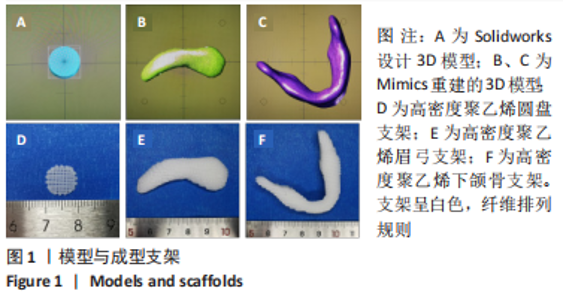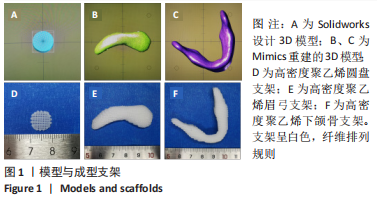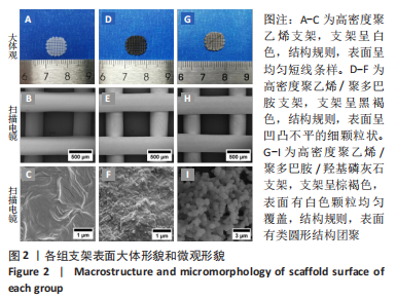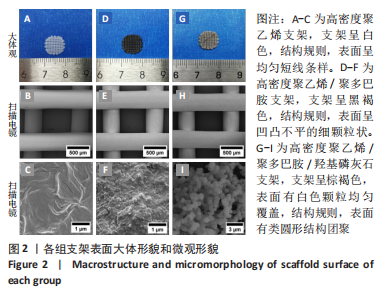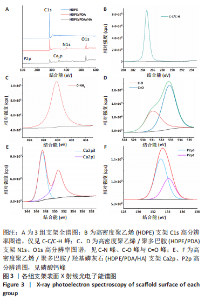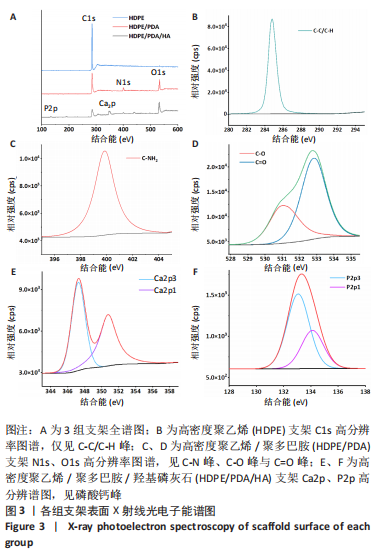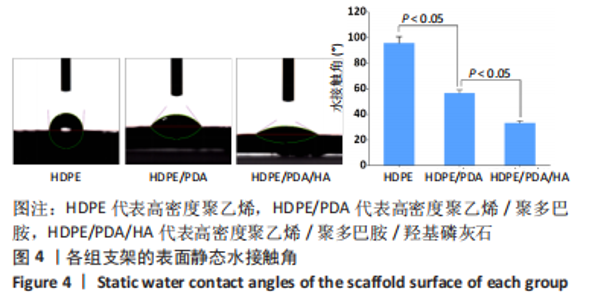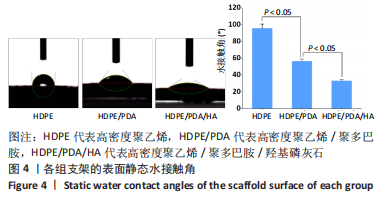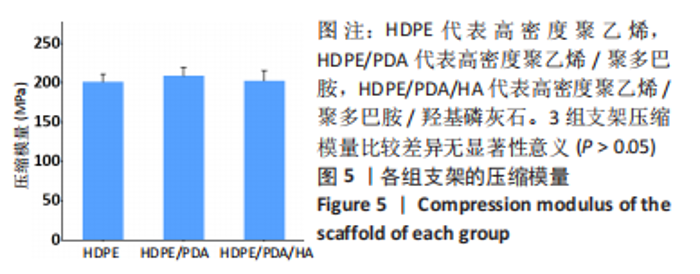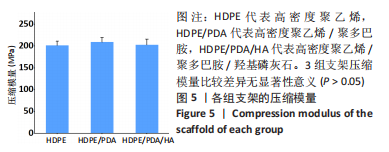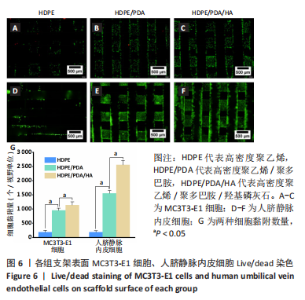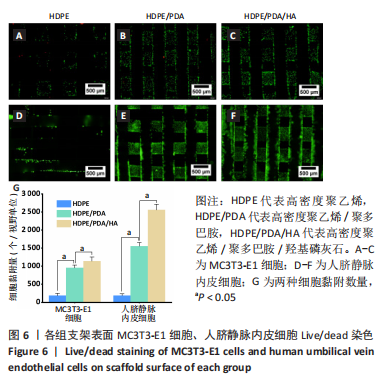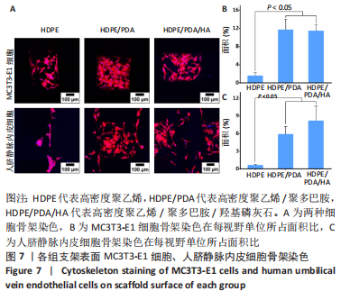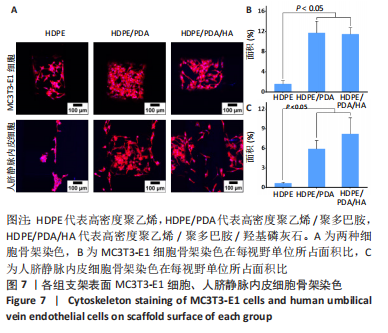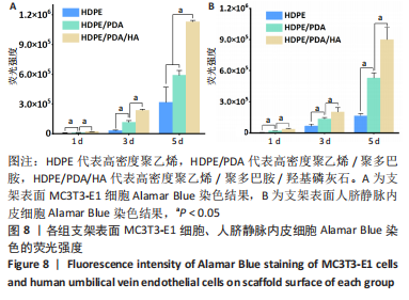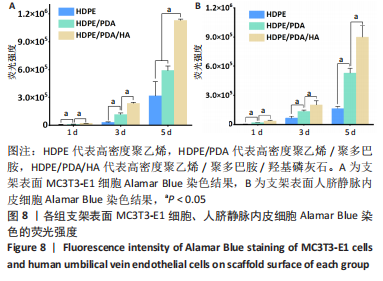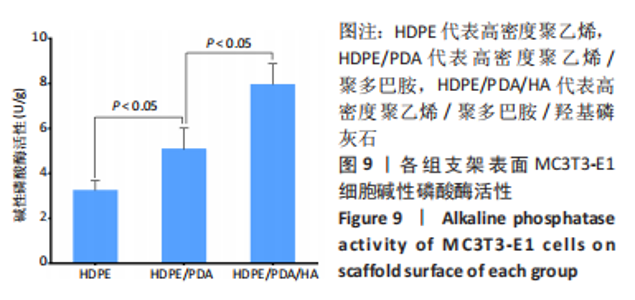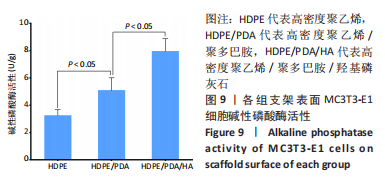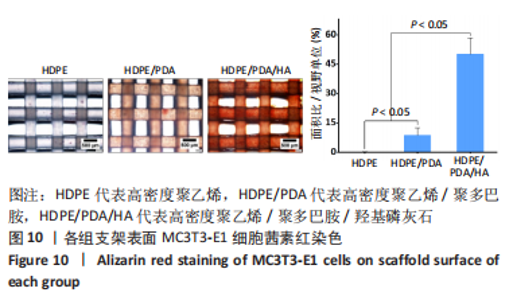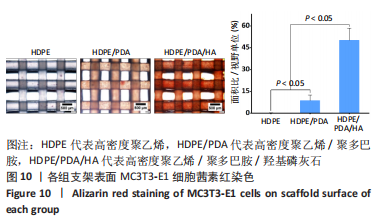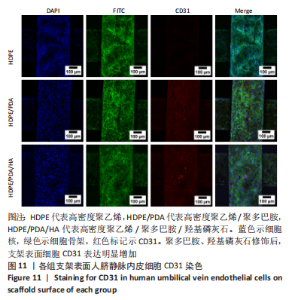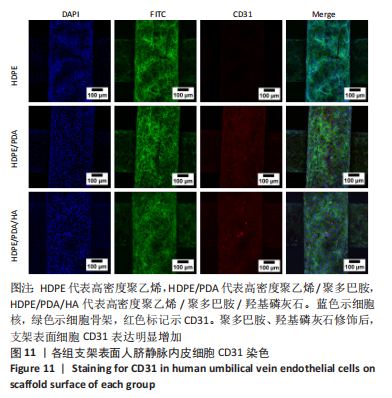Chinese Journal of Tissue Engineering Research ›› 2023, Vol. 27 ›› Issue (16): 2501-2509.doi: 10.12307/2023.451
Previous Articles Next Articles
Properties of surface coatings for 3D printed high density polyethylene scaffolds
Wang Jiejie1, Yin Junfeiyang1, Zhong Jing1, Gong Haihuan1, Wang Yilin1, Zhao Yanyan1, Li Yanbing1, Huang Wenhua1, 2
- 1Guangdong Engineering Research Center for Translation of Medical 3D Printing Application, Guangdong Provincial Key Laboratory of Medical Biomechanics, National Key Discipline of Human Anatomy, School of Basic Medical Sciences, Southern Medical University, Guangzhou 510515, Guangdong Province, China; 2Guangdong Medical Innovation Platform for Translation of 3D Printing Application, The Third Affiliated Hospital of Southern Medical University, Guangzhou 510630, Guangdong Province, China
-
Received:2022-03-09Accepted:2022-06-22Online:2023-06-08Published:2022-11-11 -
Contact:Huang Wenhua, Professor, Doctoral supervisor, Guangdong Engineering Research Center for Translation of Medical 3D Printing Application, Guangdong Provincial Key Laboratory of Medical Biomechanics, National Key Discipline of Human Anatomy, School of Basic Medical Sciences, Southern Medical University, Guangzhou 510515, Guangdong Province, China; Guangdong Medical Innovation Platform for Translation of 3D Printing Application, The Third Affiliated Hospital of Southern Medical University, Guangzhou 510630, Guangdong Province, China -
About author:Wang Jiejie, Master candidate, Guangdong Engineering Research Center for Translation of Medical 3D Printing Application, Guangdong Provincial Key Laboratory of Medical Biomechanics, National Key Discipline of Human Anatomy, School of Basic Medical Sciences, Southern Medical University, Guangzhou 510515, Guangdong Province, China -
Supported by:the National Natural Science Foundation of China, No. 31972915 (to HWH); Basic and Applied Basic Research Foundation of Guangdong Province, No. 2020B1515120001 (to HWH); Science and Technology Planning Project of Guangdong Province, No. 2018B090944002 (to LYB); Shenzhen Medical and Health “Three Project” High-Level Medical Team, No. SZSM201612019 (to HWH)
CLC Number:
Cite this article
Wang Jiejie, Yin Junfeiyang, Zhong Jing, Gong Haihuan, Wang Yilin, Zhao Yanyan, Li Yanbing, Huang Wenhua. Properties of surface coatings for 3D printed high density polyethylene scaffolds[J]. Chinese Journal of Tissue Engineering Research, 2023, 27(16): 2501-2509.
share this article
Add to citation manager EndNote|Reference Manager|ProCite|BibTeX|RefWorks
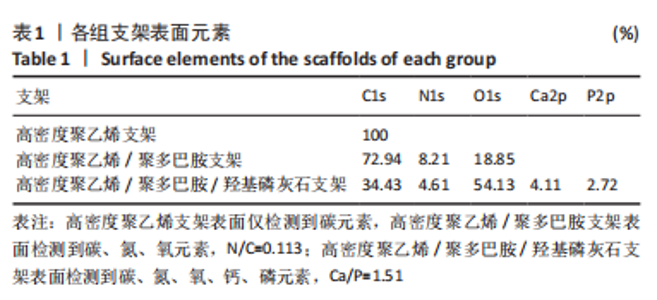
2.3 各组支架的表面元素 各组支架表面元素组成结果如表1;各组支架表面X射线光电子能谱图结果如图3。高密度聚乙烯支架表面仅检测到碳元素,全谱图中见C1s峰位,C1s高分辨图谱中检测到284.8 eV特征峰,代表C-C/C-H。高密度聚乙烯/聚多巴胺支架表面检测到碳、氮、氧元素,氮、碳元素的原子百分比比值约为0.113;全谱图中见C1s、N1s、O1s峰位;N1s高分辨图谱中检测到399.83 eV特征峰,代表C-NH2,O1s高分辨图谱中检测到530.68 eV、532.69 eV特征峰,分别代表C-O、C=O,其中C-O峰的面积小于C=O峰的面积。高密度聚乙烯/聚多巴胺/羟基磷灰石支架表面检测到碳、氮、氧、钙、磷元素,钙、磷元素的原子百分比比值约为1.51;全谱图中见C1s、N1s、O1s、Ca2p、P2p 峰位。Ca2p高分辨图谱中检测到347.36 eV 特征峰,代表磷酸钙;P2p高分辨图谱中检测到134.12 eV特征峰,代表金属磷酸盐。"
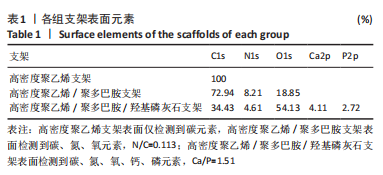
| [1] POURLAK T, POURLAK T, GHODRATI M, et al. Usage of stem cells in oral and maxillofacial region. J Stomatol Oral Maxillofac Surg. 2021;122(4): 441-452. [2] CRIST TE, MATHEW PJ, PLOTSKER EL, et al. Biomaterials in Craniomaxillofacial Reconstruction: Past, Present, and Future. J Craniofac Surg. 2021;32(2):535-540. [3] 黄燕,李小丹,欧阳山蓓,等.自体骨、生物材料在颅颌面骨缺损修复中的应用研究[J].中国美容医学,2017,26(8):89-92. [4] IACCARINO C, KOLIAS A, ADELSON PD, et al. Consensus statement from the international consensus meeting on post-traumatic cranioplasty. Acta Neurochir (Wien). 2021;163(2):423-440. [5] 谢知洋,吴国平.聚醚醚酮修复颅颌面骨缺损的应用进展[J].中华医学美学美容杂志,2021,27(6):505-508. [6] PARK H, RYU J, JUNG S, et al. Effect of Hydroxyapatite Nanoparticles and Nitrogen Plasma Treatment on Osteoblast Biological Behaviors of 3D-Printed HDPE Scaffold for Bone Tissue Regeneration Applications Materials (Basel). 2022;15(3):827. [7] SOSAKUL T, TUCHPRAMUK P, SUVANNAPRUK W, et al. Evaluation of tissue ingrowth and reaction of a porous polyethylene block as an onlay bone graft in rabbit posterior mandible. J Periodontal Implant Sci. 2020;50(2):106-120. [8] SLEPICKA P, SLEPICKOVA KASALKOVA N, STRANSKA E, et al. Surface characterization of plasma treated polymers for applications as biocompatible carriers. Exp Polym Lett. 2013;7(6):535-545. [9] MARLIER B, KLEIBER JC, BANNWARTH M, et al. Reconstruction of cranioplasty using medpor porouspolyethylene implant. Neurochirurgie. 2017;63(6):468-472. [10] CHENG L, SURESH KS, HE H, et al. 3D Printing of Micro- and Nanoscale Bone Substitutes: A Review on Technical and Translational Perspectives. Int J Nanomedicine. 2021;16:4289-4319. [11] PAXTON NC, DINORO J, REN J, et al. Additive manufacturing enables personalised porous high-density polyethylene surgical implant manufacturing with improved tissue and vascular ingrowth. Appl Mater Today. 2021;22:100965. [12] YIN J, ZHONG J, WANG J, et al. 3D-printed high-density polyethylene scaffolds with bioactive and antibacterial layer-by-layer modification for auricle reconstruction. Mater Today Bio. 2022;16:100361. [13] FENG C, XUE J, YU X, et al. Co-inspired hydroxyapatite-based scaffolds for vascularized bone regeneration. Acta Biomater. 2021;119: 419-431. [14] KOKUBO T, TAKADAMA H. How useful is SBF in predicting in vivo bone bioactivity? Biomaterials. 2006;27(15):2907-2915. [15] 刘吕花,郑延延,张丽芳,等.硬组织植入聚醚醚酮表面生物活性改性研究[J].中国塑料,2018,32(11):7-18. [16] LEE H, DELLATORE SM, MILLER WM, et al. Mussel-inspired surface chemistry for multifunctional coatings. Science. 2007;318(5849): 426-430. [17] RYU J, KU SH, LEE H, et al. Mussel-Inspired Polydopamine Coating as a Universal Route to Hydroxyapatite Crystallization. Adv Functl Mater. 2010;20(13): 2132-2139. [18] NIECHAJEV I. Facial reconstruction using porous high-density polyethylene (medpor): long-term results. Aesthetic Plast Surg. 2012; 36(4):917-927. [19] MARLIER B, KLEIBER JC, BANNWARTH M, et al. Reconstruction of cranioplasty using medpor porouspolyethylene implant. Neurochirurgie. 2017;63(6):468-472. [20] SPÄTER T, TOBIAS AL, MENGER MM, et al. Biological coating with platelet-rich plasma and adipose tissue-derived microvascular fragments improves the vascularization, biocompatibility and tissue incorporation of porous polyethylene. Acta Biomater. 2020;108:194-206. [21] WANG Z, WANG L, LI T, et al. 3D bioprinting in cardiac tissue engineering. Theranostics. 2021;11(16):7948-7969. [22] LIU X, CHEN W, SHAO B, et al. Mussel patterned with 4D biodegrading elastomer durably recruits regenerative macrophages to promote regeneration of craniofacial bone. Biomaterials. 2021;276:120998. [23] XING F, CHI Z, YANG R, et al. Chitin-hydroxyapatite-collagen composite scaffolds for bone regeneration. Int J Biol Macromol. 2021;184:170-180. [24] LI L, LI Y, YANG L, et al. Polydopamine coating promotes early osteogenesis in 3D printing porous Ti6Al4V scaffolds. Ann Transl Med. 2019;7(11):240. [25] KARAGEORGIOU V, KAPLAN D. Porosity of 3D biomaterial scaffolds and osteogenesis. Biomaterials. 2005;26(27):5474-5491. [26] MIRKHALAF M, MEN Y, WANG R, et al. Personalized 3D printed bone scaffolds: a review. Acta Biomater. 2022:S1742-7061(22)00218-5. doi: 10.1016/j.actbio.2022.04.014.. [27] LASCHKE MW, AUGUSTIN VA, SAHIN F, et al. Surface modification by plasma etching impairs early vascularization and tissue incorporation of porous polyethylene (Medpor®) implants. J Biomed Mater Res B Appl Biomater. 2016;104(8):1738-1748. [28] 汪洋,东为富.黑色素的结构、性质及其在纳米复合材料领域的应用[J].中国材料进展,2019,38(5):470-477. [29] 彭浩南,李红.聚多巴胺的发现、反应原理及应用[J].大学化学, 2022,37(X):2202011. [30] 何林,吴稀,何淞,等.经聚多巴胺涂层的羟基磷灰石生物陶瓷具有亲水性与细胞黏附性[J].中国组织工程研究,2021,25(22): 3540-3544. [31] 林子扬,常宇辰,吴章凡,等.不同模拟体液对硼硅酸盐生物活性玻璃基骨水泥矿化性能的影响[J]. 无机材料学报,2021,36(7):745-752. [32] NAOFUMI O, YUKO K, TSUBASA O. Antibacterial effect of zinc oxide/hydroxyapatite coatings prepared by chemical solution deposition. Appl Surf Sci. 2018;445:596-600. [33] 施兰,杨立军,代文豪,等.沉积温度对多孔钛表面仿生制备羟基磷灰石的影响[J].材料科学与工艺,2017,25(6):27-33. [34] 李元,宋亮,张建国,等.三维有限元分析种植体支持平面型及弹性衬垫型磁性覆盖义齿在正常骨及骨质疏松状态下的应力[J].中国组织工程研究,2022,26(16):2540-2544. [35] GRIFFIN MF, O’TOOLE G, SABBAGH W, et al. Comparison of the compressive mechanical properties of auricular and costal cartilage from patients with microtia. J Biomech. 2020;103:109688. [36] LIU G, WANG Q, YANG Q, et al. Mechanical study of polyurethane elastomer and Medpor as the material of artificial auricular scaffold. Zhongguo Xiu Fu Chong Jian Wai Ke Za Zhi. 2019;33(4):492-496. [37] BOBBERT F, ZADPOOR AA. Effects of bone substitute architecture and surface properties on cell response, angiogenesis, and structure of new bone. J Mater Chem B. 2017;5(31):6175-6192. [38] ZAREIDOOST A, YOUSEFPOUR M, GHASEME B, et al. The relationship of surface roughness and cell response of chemical surface modification of titanium. J Mater Sci Mater Med. 2012;23(6):1479-1488. [39] AL QW, SCHILLE C, SPINTZYK S, et al. Effect of surface modification of zirconia on cell adhesion, metabolic activity and proliferation of human osteoblasts. Biomed Tech (Berl). 2017;62(1):75-87. [40] HARB SV, BASSOUS NJ, DE SOUZA TAC, et al. Hydroxyapatite and β-TCP modified PMMA-TiO 2 and PMMA-ZrO2 coatings for bioactive corrosion protection of Ti6Al4V implants. Mater Sci Eng C Mater Biol Appl. 2020;116:111149. [41] LIU X, CAO J, LI H, et al. Mussel-inspired polydopamine: a biocompatible and ultrastable coating for nanoparticles in vivo. ACS Nano. 2013;7(10):9384-9395. [42] LEE DJ, TSENG HC, WONG SW, et al. Dopaminergic effects on in vitro osteogenesis. Bone Res. 2015;3:15020. [43] WANG H, LIN C, ZHANG X, et al. Mussel-Inspired Polydopamine Coating: A General Strategy To Enhance Osteogenic Differentiation and Osseointegration for Diverse Implants. ACS Appl Mater Interfaces. 2019;11(7):7615-7625. [44] HOU Y, XIE W, YU L, et al. Surface Roughness Gradients Reveal Topography-Specific Mechanosensitive Responses in Human Mesenchymal Stem Cells. Small. 2020;16(10):e1905422. [45] PIARD C, LUTHCKE R, KAMALITDINOV T, et al. Sustained delivery of vascular endothelial growth factor from mesoporous calcium-deficient hydroxyapatite microparticles promotes in vitro angiogenesis and osteogenesis. J Biomed Mater Res A. 2021;109(7):1080-1087. |
| [1] | Fang Xingyan, Tian Zhenli, Zhao Zheyi, Wen Ping, Xie Tingting. Effects of sodium arsenite on human umbilical vein endothelial cell injury and sphingosine kinases 1/sphingosine 1-phosphate signaling axis [J]. Chinese Journal of Tissue Engineering Research, 2023, 27(在线): 1-7. |
| [2] | Peng Zhixin, Yan Wengang, Wang Kun, Zhang Zhenjiang. Finite element analysis and structural optimization design of 3D printed forearm braces [J]. Chinese Journal of Tissue Engineering Research, 2023, 27(9): 1340-1345. |
| [3] | He Yinhao, Li Xiaosheng, Chen Hongwen, Chen Tiezhu. 3D printed porous tantalum metal in the treatment of developmental dysplasia of the hip: current status and application prospect [J]. Chinese Journal of Tissue Engineering Research, 2023, 27(9): 1455-1461. |
| [4] | Wang Yanjin, Zhou Yingjie, Chai Xubin, Zhuo Hanjie. Meta-analysis of the efficacy and safety of 3D printed porous titanium alloy fusion cage in anterior cervical discectomy and fusion [J]. Chinese Journal of Tissue Engineering Research, 2023, 27(9): 1434-1440. |
| [5] | Yang Zhishan, Tang Zhenglong. YAP/TAZ, a core factor of the Hippo signaling pathway, is involved in bone formation [J]. Chinese Journal of Tissue Engineering Research, 2023, 27(8): 1264-1271. |
| [6] | Zhang Tingting, Liu Juan, Zhang Xu. Bioactivity of phase-transition lysozyme for surface modification of zirconia all-ceramic implant material mediating hydroxyapatite coating [J]. Chinese Journal of Tissue Engineering Research, 2023, 27(7): 1043-1049. |
| [7] | Xu Xingxing, Wen Chaoju, Meng Maohua, Wang Qinying, Chen Jingqiao, Dong Qiang. Carbon nanomaterials in oral implant [J]. Chinese Journal of Tissue Engineering Research, 2023, 27(7): 1062-1070. |
| [8] | Yang Yitian, Wang Lu, Yao Wei, Zhao Bin. Application of the interaction between biological scaffolds and macrophages in bone regeneration [J]. Chinese Journal of Tissue Engineering Research, 2023, 27(7): 1071-1079. |
| [9] | Li Cheng, Zheng Guoshuang, Kuai Xiandong, Yu Weiting. Alginate scaffold in articular cartilage repair [J]. Chinese Journal of Tissue Engineering Research, 2023, 27(7): 1080-1088. |
| [10] | Tang Haotian, Liao Rongdong, Tian Jing. Application and design of piezoelectric materials for bone defect repair [J]. Chinese Journal of Tissue Engineering Research, 2023, 27(7): 1117-1125. |
| [11] | Liu Wentao, Feng Xingchao, Yang Yi, Bai Shengbin. Effect of M2 macrophage-derived exosomes on osteogenic differentiation of bone marrow mesenchymal stem cells [J]. Chinese Journal of Tissue Engineering Research, 2023, 27(6): 840-845. |
| [12] | Long Yanming, Xie Mengsheng, Huang Jiajie, Xue Wenli, Rong Hui, Li Xiaojie. Casein kinase 2-interaction protein-1 regulates the osteogenic ability of bone marrow mesenchymal stem cells in osteoporosis rats [J]. Chinese Journal of Tissue Engineering Research, 2023, 27(6): 878-882. |
| [13] | Li Xinyue, Li Xiheng, Mao Tianjiao, Tang Liang, Li Jiang. Three-dimensional culture affects morphology, activity and osteogenic differentiation of human periodontal ligament stem cells [J]. Chinese Journal of Tissue Engineering Research, 2023, 27(6): 846-852. |
| [14] | Yuan Wei, Liu Jingdong, Xu Guanghui, Kang Jian, Li Fuping, Wang Yingjie, Zhi Zhongzheng, Li Guanwu. Osteogenic differentiation of human perivascular stem cells and its regulation based on Wnt/beta-catenin signaling pathway [J]. Chinese Journal of Tissue Engineering Research, 2023, 27(6): 866-871. |
| [15] | Chai Hao, Yang Deyong, Zhang Lei, Shu Li. 3D printing personalized osteotomy guide technology versus conventional total knee arthroplasty on the accuracy of lower limb force alignment: a meta-analysis [J]. Chinese Journal of Tissue Engineering Research, 2023, 27(4): 646-654. |
| Viewed | ||||||
|
Full text |
|
|||||
|
Abstract |
|
|||||
